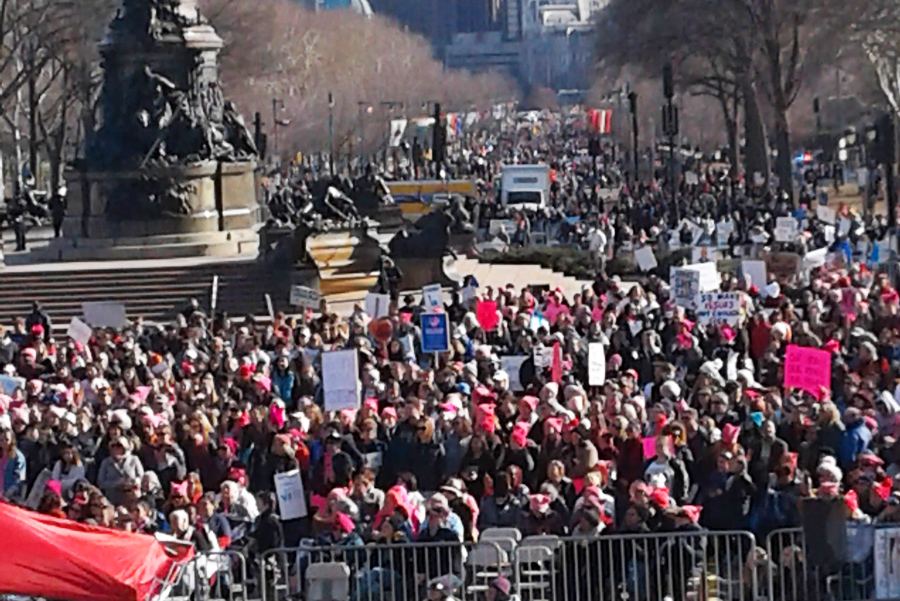When asked what it takes to organize an event for more than 50,000 people, Deja Lynn Alvarez laughs.
“A lot. It takes a lot of emotion and stress, opinions and feelings and passion. And at the end of it, all you can do is hope that you all have done everything you can possibly do to put together a safe, empowering, uplifting, truthful event.”
At least 60,000 people — some 10,000 more than last year — marched along the Benjamin Franklin Parkway last Saturday for the second-annual Women’s March in Philadelphia, on a day when similar marches were taking place in all corners of the globe. Some cities held their marches on Sunday.
The speakers ranged from local activists, including a 17-year-old girl making changes at her conservative high school, Councilwoman Maria Quiñones-Sanchez and executive director of the Office of LGBT Affairs Amber Hikes.
From the stage, Hikes called for solidarity between all women.
“Every one of us is here today because we want to be a part of the fight. But how many of us have failed to protect our sisters? What good is arriving at the top, if all it affords me is a bird’s eye view of all the sisters I left behind?”
Hikes also led the crowd in chanting, “We will stand.”
Many of the speakers called for a daily commitment to activism. Organizer Salima Suswell declared from the stage, “I would march every day if I could.”
The marchers held elaborate signs, beat drums and wore costumes, and thousands donned the electric-pink “pussy” hats that have become a popular and sometimes-controversial symbol of the movement. One group of marchers crafted an “Intersectional-asaurus,” a papier-mâché dinosaur with marginalized identities such as “transgender” and “Afro-Latinx” written throughout its design, and hung Pride flags from street lamps.
Lori Ann, a teacher who runs a support group for parents of transgender children, said, “I’m surprised by the apathy I still see in people, despite everything that has happened this year. I have really learned who people are.”
This year, in anticipation of the upcoming midterm elections, the Women’s March focused its theme on invigorating voters. Several progressive candidates’ supporters were visible, including Nina Ahmed, who resigned as Philadelphia’s deputy mayor to run for Congress, and Katie Muth, an organizer with Indivisible Mid Montco who is now running for the Pennsylvania Senate. Many of the marchers’ signs indicated a “blue wave” in the 2018 midterms.
One local leader, Jennifer North of South Jersey Women for Progressive Change, said, “If we can hear each other, we will be able to create a wide coalition that could bring us further than we’ve ever seen.”
Ahead of the event, a post circulated on social media alleging that police would be setting up checkpoints and searching bags. Some of the confusion seems to be based in the language used in the city’s press release about security measures, which included “All bags are subject to search, and therefore, the presence of bags could create delays in allowing attendees to enter the event.”
After backlash online and threats of boycotts, Deputy Commissioner Dennis Wilson three days before the event during a press conference that there would be no body searches or stop-and-frisk measures.
Alvarez also denied claims that the organizers “collaborated” with the PPD.
“In light of everything that has happened over the last year, in Las Vegas and Charlottesville, [the PPD] may have been extra vigilant. However, we did not decide to collaborate with the police. I think there has been misinformation out there.
“We understand and sympathize with those concerns about police officers, especially for women of color, cis[gender] and trans,” she said. “As a trans woman, I spent many years being abused by the police and it is understandably difficult for some communities to even trust the words of the police when they have seen so much wrong done to them.”
Despite the controversy, the local march was energetic and attendees expressed positive hopes for the future. The organizers are working on “get out the vote” actions in anticipation of the November midterm elections.
